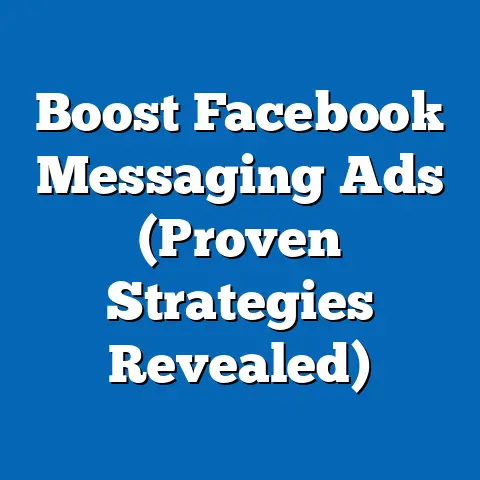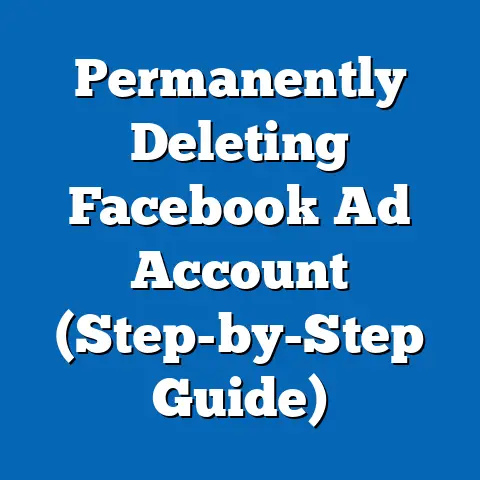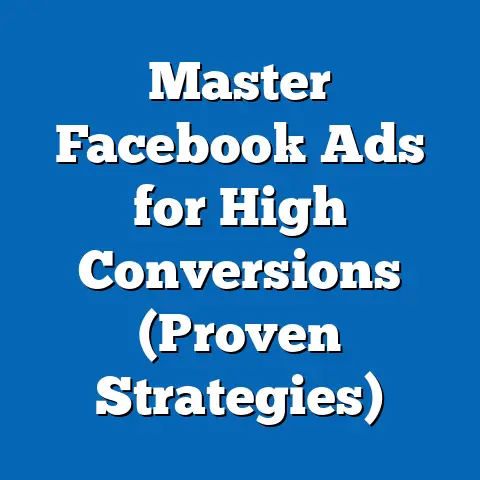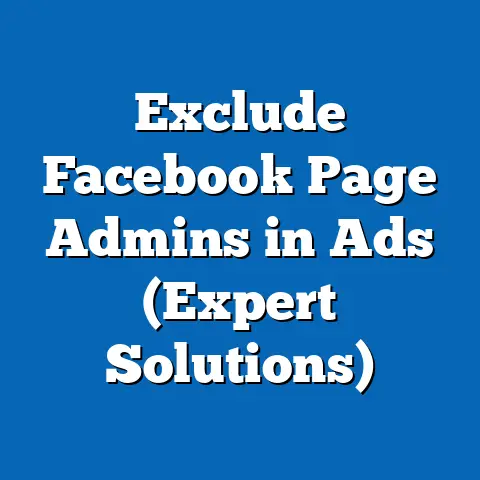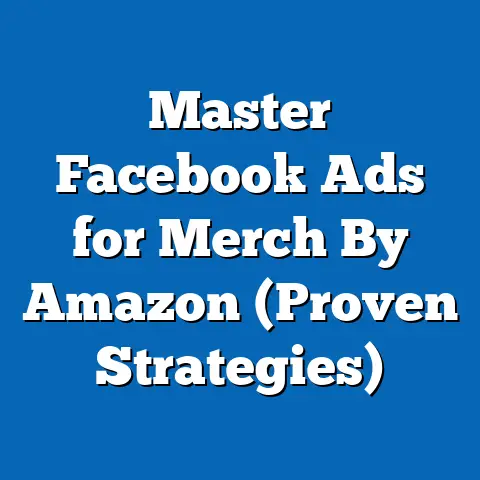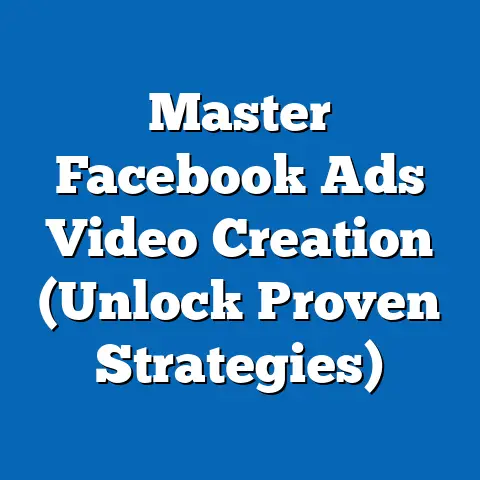Unlocking Competitor Insights (Proven fb ad Strategies)
In the cutthroat world of Facebook advertising, many businesses are left scratching their heads, wondering why their ad spend isn’t translating into the ROI they hoped for. Some brands seem to effortlessly capture attention and drive conversions, while others struggle to break through the noise. I’ve seen this firsthand, consulting with businesses that have poured money into Facebook ads without a clear understanding of what their competitors are doing right. The truth is, success on Facebook isn’t just about having a great product or service; it’s about understanding the landscape and knowing how to position yourself effectively.
That’s where competitor analysis comes in. It’s not about copying what others are doing, but about gaining valuable insights that can help you tailor your ad strategies, refine your targeting, and ultimately, outperform your rivals. In this guide, I’ll walk you through the process of unlocking these competitor insights, providing you with the tools, techniques, and strategies you need to elevate your Facebook ad game.
The Importance of Competitor Insights
Think of Facebook advertising as a battlefield. You wouldn’t go into battle without knowing your enemy, would you? Competitor insights are your intelligence reports, giving you a clear picture of your rivals’ strengths, weaknesses, and strategies. By understanding what your competitors are doing, you can identify successful tactics, understand your target audience’s preferences, and spot emerging content trends.
I remember working with a small e-commerce business that was struggling to gain traction on Facebook. They were running generic ads with little to no engagement. After conducting a thorough competitor analysis, we discovered that their main competitor was using highly personalized video ads that resonated deeply with their target audience. We adapted this strategy, creating our own personalized video ads, and saw a significant increase in engagement and conversions.
Competitor analysis isn’t just about copying; it’s about learning. It allows you to make informed strategic decisions, allocate resources effectively, and stay ahead in the ever-evolving digital marketing environment. Without it, you’re essentially flying blind, relying on guesswork instead of data-driven insights.
Key Takeaway: Competitor analysis provides crucial intelligence that informs your Facebook ad strategy, helps you understand your audience, and keeps you ahead of the competition.
Tools and Techniques for Analyzing Competitor Ads
Fortunately, there are a variety of tools and techniques available to help you analyze your competitors’ Facebook ads. Here are a few of my favorites:
-
Facebook Ad Library: This is Facebook’s own tool, and it’s a goldmine of information. You can search for any Facebook Page and see all the active ads they are running. This allows you to analyze their ad copy, visuals, targeting (to some extent), and the dates they started running the ads.
- How to Use: Simply go to the Facebook Ad Library (https://www.facebook.com/ads/library), select “All” for ad category, and enter the name of the Facebook Page you want to analyze.
I often use the Facebook Ad Library to quickly get a sense of what my competitors are currently promoting. It’s a great way to stay on top of their latest campaigns and identify any new trends they might be exploring.
-
AdSpy: AdSpy is a paid tool that offers more advanced features than the Facebook Ad Library. It allows you to search for ads based on keywords, demographics, interests, and even technologies used in the ad.
- How to Use: After signing up for AdSpy, you can use their search filters to narrow down your search to specific criteria. For example, you can search for ads targeting women aged 25-35 who are interested in yoga.
I’ve found AdSpy particularly useful for identifying niche targeting strategies that my competitors are using. It gives you a deeper dive into their audience segmentation and helps you understand who they’re trying to reach.
-
SEMrush: While SEMrush is primarily known as an SEO tool, it also offers features for analyzing competitor advertising. You can use SEMrush to identify the keywords your competitors are bidding on in their Facebook ads, as well as their estimated ad spend.
- How to Use: Navigate to the “Advertising Research” section in SEMrush and enter your competitor’s domain name. You’ll be able to see their top keywords, ad copy, and estimated traffic.
SEMrush is a great tool for understanding the overall advertising strategy of your competitors, not just on Facebook, but across multiple platforms.
-
Manually Tracking and Analyzing: Don’t underestimate the power of simply scrolling through your own Facebook feed and paying attention to the ads you see. You can learn a lot by analyzing the ads that are targeted to you and your friends.
- How to Use: Pay attention to the ads you see in your feed. Note the ad copy, visuals, call-to-action, and the reasons why you think the ad was targeted to you.
I often ask my friends and family to share screenshots of the ads they’re seeing on Facebook. This gives me a broader perspective on the advertising landscape and helps me identify trends that I might have missed.
Facebook Ad Library: This is Facebook’s own tool, and it’s a goldmine of information. You can search for any Facebook Page and see all the active ads they are running. This allows you to analyze their ad copy, visuals, targeting (to some extent), and the dates they started running the ads.
- How to Use: Simply go to the Facebook Ad Library (https://www.facebook.com/ads/library), select “All” for ad category, and enter the name of the Facebook Page you want to analyze.
I often use the Facebook Ad Library to quickly get a sense of what my competitors are currently promoting. It’s a great way to stay on top of their latest campaigns and identify any new trends they might be exploring.
AdSpy: AdSpy is a paid tool that offers more advanced features than the Facebook Ad Library. It allows you to search for ads based on keywords, demographics, interests, and even technologies used in the ad.
- How to Use: After signing up for AdSpy, you can use their search filters to narrow down your search to specific criteria. For example, you can search for ads targeting women aged 25-35 who are interested in yoga.
I’ve found AdSpy particularly useful for identifying niche targeting strategies that my competitors are using. It gives you a deeper dive into their audience segmentation and helps you understand who they’re trying to reach.
SEMrush: While SEMrush is primarily known as an SEO tool, it also offers features for analyzing competitor advertising. You can use SEMrush to identify the keywords your competitors are bidding on in their Facebook ads, as well as their estimated ad spend.
- How to Use: Navigate to the “Advertising Research” section in SEMrush and enter your competitor’s domain name. You’ll be able to see their top keywords, ad copy, and estimated traffic.
SEMrush is a great tool for understanding the overall advertising strategy of your competitors, not just on Facebook, but across multiple platforms.
Manually Tracking and Analyzing: Don’t underestimate the power of simply scrolling through your own Facebook feed and paying attention to the ads you see. You can learn a lot by analyzing the ads that are targeted to you and your friends.
- How to Use: Pay attention to the ads you see in your feed. Note the ad copy, visuals, call-to-action, and the reasons why you think the ad was targeted to you.
I often ask my friends and family to share screenshots of the ads they’re seeing on Facebook. This gives me a broader perspective on the advertising landscape and helps me identify trends that I might have missed.
Key Takeaway: Utilize a combination of tools like Facebook Ad Library, AdSpy, and SEMrush to gather comprehensive data on your competitors’ ad strategies. Don’t forget the power of manual observation and analysis.
Identifying Successful Ad Elements
Once you’ve gathered data on your competitors’ ads, the next step is to identify the elements that make them successful. Here’s a breakdown of key components to analyze:
-
Ad Copy: What kind of language are they using? Are they focusing on benefits or features? Are they using humor or a more serious tone? Pay attention to the headlines, body text, and calls-to-action.
- Example: A competitor might be using a headline that focuses on solving a specific pain point, such as “Tired of Sleepless Nights? Discover Our Natural Sleep Aid.”
I always analyze the ad copy to see how my competitors are positioning their products or services. Are they targeting a specific emotion? Are they highlighting a unique selling proposition?
-
Visuals: Are they using images or videos? Are the visuals high-quality and engaging? Do they feature people or products? What kind of colors and design elements are they using?
- Example: A competitor might be using a video ad that showcases their product in action, demonstrating its benefits in a visually appealing way.
I pay close attention to the visuals to see what kind of aesthetic my competitors are using. Are they going for a minimalist look or something more vibrant and eye-catching?
-
Call-to-Action (CTA): What are they asking people to do? Are they using a standard CTA like “Learn More” or something more specific like “Get Your Free Trial”?
- Example: A competitor might be using a CTA like “Shop Now and Get 20% Off” to incentivize immediate action.
I analyze the CTAs to see how my competitors are driving conversions. Are they using urgency or scarcity to encourage people to click?
-
Audience Targeting: While you can’t see the exact targeting criteria your competitors are using, you can make educated guesses based on the ads you see and the information you have about their target audience.
- Example: If you see an ad for a baby product, it’s likely targeted to parents or expectant parents.
I use my knowledge of my target audience to infer who my competitors are trying to reach. This helps me refine my own targeting strategies.
Ad Copy: What kind of language are they using? Are they focusing on benefits or features? Are they using humor or a more serious tone? Pay attention to the headlines, body text, and calls-to-action.
- Example: A competitor might be using a headline that focuses on solving a specific pain point, such as “Tired of Sleepless Nights? Discover Our Natural Sleep Aid.”
I always analyze the ad copy to see how my competitors are positioning their products or services. Are they targeting a specific emotion? Are they highlighting a unique selling proposition?
Visuals: Are they using images or videos? Are the visuals high-quality and engaging? Do they feature people or products? What kind of colors and design elements are they using?
- Example: A competitor might be using a video ad that showcases their product in action, demonstrating its benefits in a visually appealing way.
I pay close attention to the visuals to see what kind of aesthetic my competitors are using. Are they going for a minimalist look or something more vibrant and eye-catching?
Call-to-Action (CTA): What are they asking people to do? Are they using a standard CTA like “Learn More” or something more specific like “Get Your Free Trial”?
- Example: A competitor might be using a CTA like “Shop Now and Get 20% Off” to incentivize immediate action.
I analyze the CTAs to see how my competitors are driving conversions. Are they using urgency or scarcity to encourage people to click?
Audience Targeting: While you can’t see the exact targeting criteria your competitors are using, you can make educated guesses based on the ads you see and the information you have about their target audience.
- Example: If you see an ad for a baby product, it’s likely targeted to parents or expectant parents.
I use my knowledge of my target audience to infer who my competitors are trying to reach. This helps me refine my own targeting strategies.
To gauge the success of these elements, assess metrics such as engagement rates (likes, comments, shares), click-through rates (CTR), and conversion rates (if available). High engagement and CTRs indicate that the ad is resonating with the target audience.
Key Takeaway: Analyze ad copy, visuals, CTAs, and audience targeting to identify successful elements in your competitors’ ads. Use engagement rates, CTRs, and conversion rates to gauge their effectiveness.
Implementing Insights into Your Own Strategy
Now that you’ve gathered insights from your competitor analysis, it’s time to put them into action. Here are some actionable steps to incorporate these insights into your own Facebook ad strategy:
-
Tailor Your Ad Content: Use what you’ve learned about your competitors’ successful ads to create content that resonates with your target audience. This doesn’t mean copying their ads verbatim, but rather adapting their strategies to fit your brand and messaging.
- Example: If you see that your competitors are using video ads that focus on customer testimonials, create your own video ads featuring your satisfied customers.
I always emphasize the importance of originality. Don’t just copy what your competitors are doing; put your own spin on it and make it unique to your brand.
-
Differentiate Your Brand: Identify what makes your brand unique and highlight those differentiators in your ads. This will help you stand out from the competition and attract customers who are looking for something different.
- Example: If your brand is known for its sustainable practices, highlight that in your ads to appeal to environmentally conscious customers.
I work with clients to identify their unique selling proposition and incorporate it into their ad messaging. This helps them attract customers who are specifically looking for what they offer.
-
Test and Iterate: Continuously test different ad variations to see what performs best. Use A/B testing to compare different headlines, visuals, and CTAs. Track your results and make adjustments based on the data.
- Example: Run two versions of the same ad with different headlines to see which one generates a higher CTR.
I’m a big believer in A/B testing. It’s the best way to optimize your ads and ensure that you’re getting the most out of your ad spend.
-
Refine Your Targeting: Use insights about your competitors’ audience to refine your own targeting. If you are seeing a competitor target a specific demographic, it may be worth testing that demo for your product as well.
-
Stay Updated: The Facebook advertising landscape is constantly changing, so it’s important to stay updated on the latest trends and best practices. Continuously monitor your competitors’ ads and adjust your strategy accordingly.
Tailor Your Ad Content: Use what you’ve learned about your competitors’ successful ads to create content that resonates with your target audience. This doesn’t mean copying their ads verbatim, but rather adapting their strategies to fit your brand and messaging.
- Example: If you see that your competitors are using video ads that focus on customer testimonials, create your own video ads featuring your satisfied customers.
I always emphasize the importance of originality. Don’t just copy what your competitors are doing; put your own spin on it and make it unique to your brand.
Differentiate Your Brand: Identify what makes your brand unique and highlight those differentiators in your ads. This will help you stand out from the competition and attract customers who are looking for something different.
- Example: If your brand is known for its sustainable practices, highlight that in your ads to appeal to environmentally conscious customers.
I work with clients to identify their unique selling proposition and incorporate it into their ad messaging. This helps them attract customers who are specifically looking for what they offer.
Test and Iterate: Continuously test different ad variations to see what performs best. Use A/B testing to compare different headlines, visuals, and CTAs. Track your results and make adjustments based on the data.
- Example: Run two versions of the same ad with different headlines to see which one generates a higher CTR.
I’m a big believer in A/B testing. It’s the best way to optimize your ads and ensure that you’re getting the most out of your ad spend.
Refine Your Targeting: Use insights about your competitors’ audience to refine your own targeting. If you are seeing a competitor target a specific demographic, it may be worth testing that demo for your product as well.
Stay Updated: The Facebook advertising landscape is constantly changing, so it’s important to stay updated on the latest trends and best practices. Continuously monitor your competitors’ ads and adjust your strategy accordingly.
Key Takeaway: Tailor your ad content, differentiate your brand, test and iterate, and stay updated to effectively incorporate competitor insights into your Facebook ad strategy.
Case Studies of Brands That Succeeded Using Competitor Insights
Let’s take a look at a few real-world examples of brands that have successfully leveraged competitor insights to enhance their Facebook ad campaigns:
-
Brand A (E-commerce): This e-commerce brand was struggling to compete with larger retailers in their niche. After conducting a competitor analysis, they discovered that their competitors were heavily focused on product features and technical specifications. Brand A decided to take a different approach, focusing on the emotional benefits of their products and telling stories that resonated with their target audience. This resulted in a significant increase in engagement and conversions.
- Lesson Learned: Sometimes, going against the grain and focusing on emotional benefits can be more effective than simply highlighting product features.
-
Brand B (Service Industry): This service industry brand was having trouble attracting new customers through Facebook ads. They noticed that their competitors were using highly professional, polished ads that felt impersonal and distant. Brand B decided to take a more authentic approach, using user-generated content and showcasing real-life customer experiences. This made their ads feel more relatable and trustworthy, leading to a higher conversion rate.
- Lesson Learned: Authenticity and transparency can be powerful tools for building trust and attracting new customers.
-
Brand C (Software): A software company noticed competitors’ ads were largely focused on product features. The company decided to focus on customer success stories and testimonials to showcase the product’s real-world impact. The company saw a 40% increase in lead generation as a result.
- Lesson Learned: Real-world proof and social validation can be very effective in driving conversions.
Brand A (E-commerce): This e-commerce brand was struggling to compete with larger retailers in their niche. After conducting a competitor analysis, they discovered that their competitors were heavily focused on product features and technical specifications. Brand A decided to take a different approach, focusing on the emotional benefits of their products and telling stories that resonated with their target audience. This resulted in a significant increase in engagement and conversions.
- Lesson Learned: Sometimes, going against the grain and focusing on emotional benefits can be more effective than simply highlighting product features.
Brand B (Service Industry): This service industry brand was having trouble attracting new customers through Facebook ads. They noticed that their competitors were using highly professional, polished ads that felt impersonal and distant. Brand B decided to take a more authentic approach, using user-generated content and showcasing real-life customer experiences. This made their ads feel more relatable and trustworthy, leading to a higher conversion rate.
- Lesson Learned: Authenticity and transparency can be powerful tools for building trust and attracting new customers.
Brand C (Software): A software company noticed competitors’ ads were largely focused on product features. The company decided to focus on customer success stories and testimonials to showcase the product’s real-world impact. The company saw a 40% increase in lead generation as a result.
- Lesson Learned: Real-world proof and social validation can be very effective in driving conversions.
Key Takeaway: These case studies demonstrate that competitor insights can be used to develop unique and effective Facebook ad strategies that differentiate your brand and resonate with your target audience.
Conclusion
In conclusion, competitor insights are a powerful resource that can significantly improve your Facebook ad performance. By understanding what your competitors are doing, you can tailor your ad strategies, refine your targeting, and ultimately, outperform your rivals.
Remember to utilize the tools and techniques discussed in this guide, including the Facebook Ad Library, AdSpy, and SEMrush. Analyze your competitors’ ad copy, visuals, CTAs, and audience targeting to identify successful elements. Incorporate these insights into your own strategy by tailoring your ad content, differentiating your brand, testing and iterating, and staying updated.
Don’t be afraid to experiment and try new things. The Facebook advertising landscape is constantly evolving, so it’s important to be adaptable and willing to change your approach as needed.
So, what are you waiting for? Start analyzing your competitors today and unlock your full advertising potential! Take the time to explore the tools I’ve mentioned, identify your key competitors, and see what they’re doing right (and wrong). Use that information to craft your own winning Facebook ad strategy. I’m confident that by implementing these strategies, you’ll see a significant improvement in your results. Good luck!

